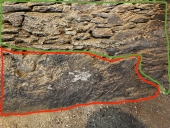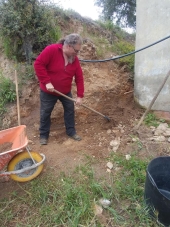




Glenn Herbert wrote:A question on mortar... What kind of mortar are you thinking of using?
Old stonework is all done with lime mortar, which is generally softer than the stone and self-heals to a degree if cracked. Much recent repair of old stone/brickwork uses modern cement mortar which is totally rigid, may be stronger than the stone/brick, and leads to damage.
What is the chance that the lower part of this fireplace wall was repointed/rendered with cement mortar?

James Freyr wrote:If there is indeed a layer of mortar or something of the like over those stones, it appears to me to be in sound condition which makes me think that the mortar holding the stones together is good and doesn't need point tucking.

Hugo Morvan wrote:Hi Mark. Looks like one big stone to me. Could it be the bedrock? Very neatly chisseled off?
If it isn’t then joints have to walk through the highlighted bit on your pic.
Could be some old cement mixed in with bits of the same stone your wall consists off. Then just try to get in there from the upper joints down. Using a chissle and hammer. Place the chissle right there where you expecr the joint. Place it standing up and hit down.
